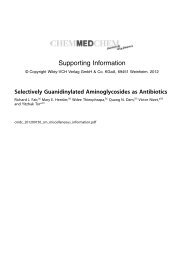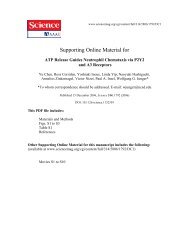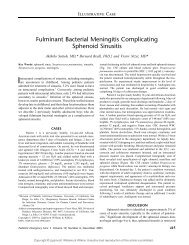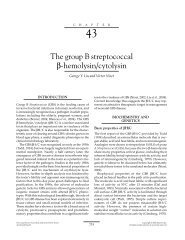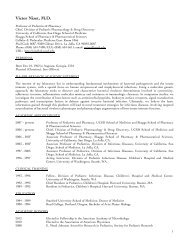BACTERIAL SEPSIS AND MENINGITIS - Nizet Laboratory at UCSD
BACTERIAL SEPSIS AND MENINGITIS - Nizet Laboratory at UCSD
BACTERIAL SEPSIS AND MENINGITIS - Nizet Laboratory at UCSD
Create successful ePaper yourself
Turn your PDF publications into a flip-book with our unique Google optimized e-Paper software.
The infected infant can be an important source of<br />
infection to family members. In one study in New York<br />
[714], 12.6% of household contacts developed suppur<strong>at</strong>ive<br />
lesions during the 10-month period after introduction<br />
into the home of an infant with a staphylococcal<br />
lesion. The incidence of suppur<strong>at</strong>ive infections in household<br />
contacts of infants without lesions was less than<br />
2%. Dam<strong>at</strong>o and coworkers [713] showed coloniz<strong>at</strong>ion<br />
of neon<strong>at</strong>es with enteric organisms possessing R factor–<br />
medi<strong>at</strong>ed resistance to kanamycin and persistence of these<br />
strains for more than 12 months after birth. During the<br />
period of observ<strong>at</strong>ion, one third of the household contacts<br />
of the infants became colonized with the same strain.<br />
Infections in infants have been associ<strong>at</strong>ed with bites or<br />
licks from household pets. Pasteurella multocida is part of<br />
the oral flora of dogs, c<strong>at</strong>s, and rodents. A review of 25<br />
cases of P. multocida infection in the neon<strong>at</strong>al period<br />
found animal exposure to c<strong>at</strong>s or dogs or both in 52%<br />
of cases, most of which did not involve bites or trauma;<br />
the balance were believed to represent vertical transmission<br />
from an infected mother [715]. In one case report,<br />
a 5-week-old infant with P. multocida meningitis frequently<br />
was licked by the family dog, and the organism<br />
was identified in cultures of the dog’s mouth, but not of<br />
the parents’ thro<strong>at</strong>s [716]. P. multocida sepsis and meningitis<br />
was reported in 2-month-old twin infants after household<br />
exposure to a slaughtered sheep [717]. A neon<strong>at</strong>al<br />
case of Campylobacter jejuni sepsis was proven genetically<br />
to result from transmission from the family dog [718].<br />
The epidemiologic link between c<strong>at</strong>s and dogs and infection<br />
in young infants suggests th<strong>at</strong> parents should limit<br />
contact between pets and infants.<br />
FEVER IN THE FIRST MONTH OF LIFE<br />
Reviews of fever in the first weeks of life indic<strong>at</strong>e th<strong>at</strong> elev<strong>at</strong>ion<br />
of temper<strong>at</strong>ure (>38.8 C[>101.8 F]) [719–724]<br />
is rel<strong>at</strong>ively uncommon. When fever occurs in the young<br />
infant, the incidence of severe disease, including bacterial<br />
sepsis, meningitis, and pneumonia, is sufficiently high to<br />
warrant careful evalu<strong>at</strong>ion and conserv<strong>at</strong>ive management<br />
[719,725]. Approxim<strong>at</strong>ely 12% of all febrile (>38 C<br />
[>100.4 F]) neon<strong>at</strong>es presenting to emergency departments<br />
are found to have a serious bacterial infection<br />
[726,727]. Important p<strong>at</strong>hogens in neon<strong>at</strong>al age group<br />
include GBS and E. coli, and occult bacteremia and urinary<br />
tract infections are the most common foci of disease<br />
[726,727].<br />
A careful history of the pregnancy, delivery, nursery<br />
experience, interval since discharge from the nursery,<br />
and infections in the household should be obtained. Physical<br />
examin<strong>at</strong>ion should establish the presence or absence<br />
of signs associ<strong>at</strong>ed with congenital infection and l<strong>at</strong>eonset<br />
diseases. Culture of blood and urine should be done<br />
if no other focus is apparent, and culture of CSF and a<br />
chest radiograph should be considered if the infant is<br />
believed to have systemic infection. Risk str<strong>at</strong>ific<strong>at</strong>ion<br />
algorithms have been evalu<strong>at</strong>ed to incorpor<strong>at</strong>e ancillary<br />
clinical testing in hopes of supplementing the often<br />
incomplete picture th<strong>at</strong> emerges from history and physical<br />
examin<strong>at</strong>ion [725].<br />
CHAPTER 6 Bacterial Sepsis and Meningitis<br />
The “Rochester criteria” for analysis of febrile infants,<br />
originally proposed by Dagan and colleagues [722], used<br />
criteria such as normal peripheral leukocyte count (5000<br />
to 15,000/mm 3 ), normal absolute band neutrophil count<br />
(



